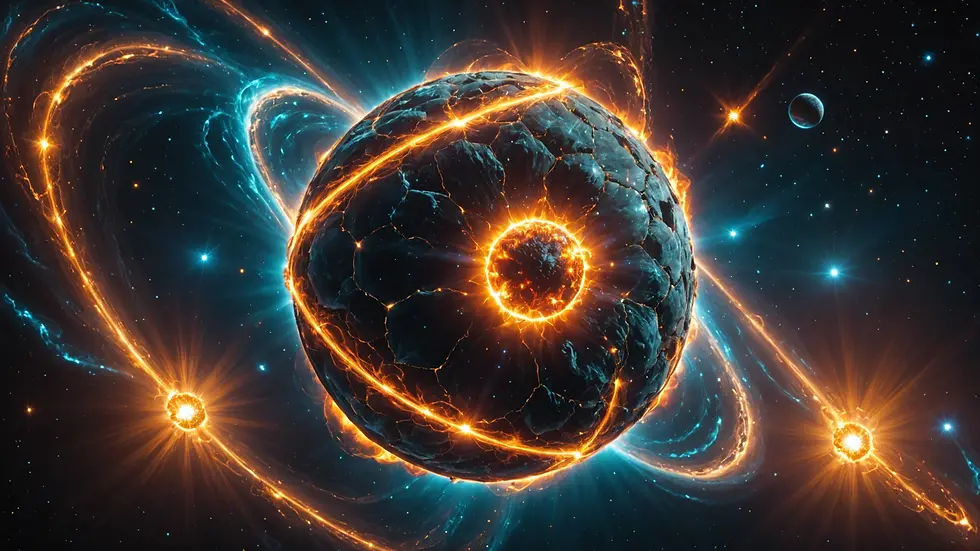What Lies Beyond: Exploring The Bizarre Phenomena of Magnetars and White Dwarfs in Space
- April C.

- Mar 3
- 4 min read
The universe is a treasure trove of wonders that stimulate our imagination and challenge our understanding of physics and existence. Among the most captivating objects are magnetars and white dwarfs, intriguing celestial entities that excite both scientists and space enthusiasts. This post explores the distinctive characteristics of magnetars and white dwarfs, highlighting what separates them from other astronomical objects and what makes them truly unique.
What is a Magnetar?
Magnetars are a specialized type of neutron star, one of the densest forms of matter known. These extraordinary stars are born from massive stars that have exploded in supernovae, leaving behind incredibly compact remnants. What distinguishes magnetars is their exceedingly strong magnetic fields, which can reach strengths over 10^11 teslas—more than 1,000 times stronger than typical neutron stars.
These immense magnetic fields influence the behavior of matter nearby, creating intense bursts of gamma rays and X-rays. For example, when a magnetar emits a burst, it can release energy equivalent to that of several billion suns within a fraction of a second. This makes them some of the brightest objects in the universe. Furthermore, magnetars can fracture their own crust due to these magnetic forces, which results in bizarre phenomena like giant flares—events that can be detected across vast distances in space.

The Life Cycle of a Magnetar
Magnetars, like all celestial bodies, go through significant changes during their existence. They often last for about 10,000 years in the active phase, emitting powerful bursts before their magnetic fields start to decay. Over longer periods, their brightness diminishes, and they may transition into a quieter state, yet they remain among the densest matter classes.
Studying the life cycle of magnetars sheds light on the lives and deaths of massive stars and their impacts on the universe. Researchers aim not only to understand their unique properties but also to explore their role in the grand cosmic tapestry.
How Do Magnetars Affect Their Surroundings?
The magnetic forces exerted by magnetars lead to fascinating effects in their environments. For example, during a magnetar's burst, the energy produced can be as much as 100 million times stronger than the typical energy output of a normal star. These bursts can frequently occur at intervals of a few seconds to several minutes, revealing crucial information about the magnetar's internal structure.
Moreover, the strong magnetic fields can distort the nuclei of nearby atoms, forming exotic matter and creating high-energy environments. Such interactions enrich our understanding of physics, especially under extreme conditions, as researchers investigate how matter behaves in these unique circumstances.

What is a White Dwarf?
In stark contrast to magnetars, white dwarfs represent a different phase in stellar evolution. When medium-sized stars, like our Sun, exhaust their nuclear fuel, they shed their outer layers, leaving behind a hot, dense core—a white dwarf. This core is primarily composed of carbon and oxygen.
White dwarfs hold a special place in astrophysics because they reveal critical aspects of stellar evolution. They may lack the strong magnetic fields found in magnetars, but they are incredibly dense, with a mass comparable to that of our Sun compressed into a volume similar to that of Earth. Over billions of years, they cool and fade, eventually becoming what we call black dwarfs—however, it's important to note that none have been observed yet, as the universe isn't old enough for this stage to exist.
The Characteristics of White Dwarfs
White dwarfs exhibit several notable features that make them essential study subjects in the field:
High Density: A piece of white dwarf material the size of a sugar cube could weigh around three tons, illustrating their extreme density.
Compact Size: Despite their significant mass, these stars have diameters comparable to Earth, showcasing a remarkable contrast between size and density.
Cooling Timeline: Unlike many other celestial objects, white dwarfs cool over billions of years, allowing astronomers to use them as cosmic clocks to measure the age of stars and galaxies.
Uniform Composition: The simpler composition of white dwarfs helps astronomers analyze them more accurately, making them easier targets for research.

The Role of Magnetars and White Dwarfs in Stellar Evolution
Both magnetars and white dwarfs are vital to astrophysical research, offering valuable insights into the processes that shape the universe. Advanced studies of magnetars enhance our comprehension of high-energy physics and how matter behaves under immense gravitational and magnetic forces. On the other hand, white dwarfs help astronomers estimate the ages of various celestial phenomena, revealing how the universe evolves over time.
These celestial bodies also provide essential clues regarding the interplay of gravity, magnetism, and nuclear processes in space. Understanding these interactions allows researchers to enhance their knowledge of cosmic history and the future pathways of stars and galaxies.
The Journey Ahead
The universe is an intricate landscape filled with extraordinary phenomena, where magnetars and white dwarfs are two of the most fascinating players in this cosmic drama. With their extreme properties, magnetars challenge our current understanding of physics, while white dwarfs illuminate the later stages of star life cycles.
As we deepen our exploration of these stellar oddities, we remember just how vast and complex our universe is. The study of magnetars and white dwarfs enriches not only our grasp of astrophysics but also our appreciation for the grand cosmic narratives unfolding beyond our planet.
By investigating these bizarre phenomena, we spark greater curiosity and inspire future generations of explorers. The secrets of our universe await discovery, reminding us that there is so much more to learn about what lies beyond the stars.
By: April Carson
---
Exploring the Origins of the Emerald Tablets: Fact or Fiction? Ft: Billy Carson & Timothy Hogan.
Ready to elevate your consciousness and expand your mind?









Comments